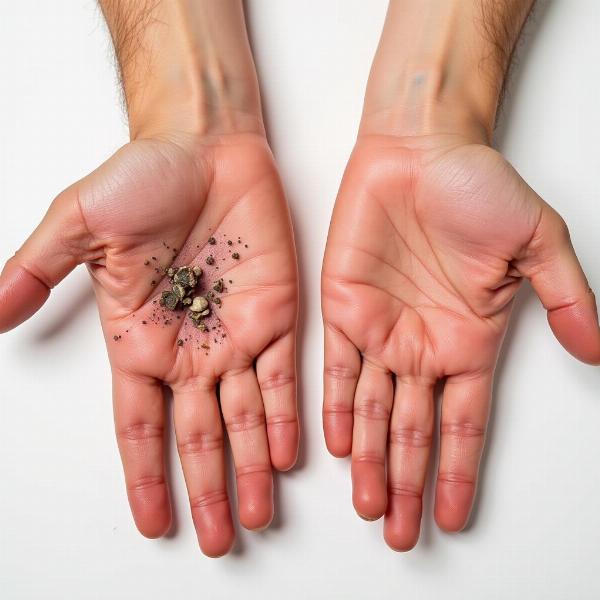Callosities, those hardened areas of skin, are a common occurrence. But what exactly are they called in Hindi, and what do they signify? This guide will delve into the meaning of “callosities meaning in Hindi,” exploring various translations, cultural contexts, and related terminology.
Understanding Callosities and Their Hindi Equivalents
Callosities are thickened areas of skin that develop due to repeated friction or pressure. In Hindi, several words can be used to describe callosities, each with slightly different nuances. The most common translation is घिसाव (ghisav), which literally means “abrasion” or “wearing away.” This term accurately reflects the process by which callosities form. Another common word is मोठा (motha), which specifically refers to a callus on the hand or foot. This term is particularly relevant in Indian culture, where manual labor and walking barefoot are common. Less frequently, you might encounter the word रगड़ (ragad), meaning “rubbing” or “friction,” which highlights the cause of callus formation.
 Callosities on Hands
Callosities on Hands
Cultural Significance of Callosities in India
In India, callosities often hold cultural significance. They can be seen as a symbol of hard work and resilience, particularly in rural communities where manual labor is prevalent. For instance, farmers and laborers often develop callosities on their hands and feet due to their demanding work. These callosities are not viewed as a blemish but rather as a badge of honor, a testament to their dedication and perseverance. Conversely, in some contexts, callosities might be associated with lower social status, as they can indicate a life of physical toil.
Different Types of Callosities and Their Hindi Names
While ghisav and motha are general terms, specific types of callosities have their own Hindi names. For example, a corn (a type of callus that develops on the toes) is often referred to as गोखरू (gokhru), which literally means “caltrop,” a thorny plant. This name alludes to the painful nature of corns. Similarly, a callus on the heel might be called एड़ी का मोठा (edi ka motha), literally “heel’s callus.”
Treating Callosities: Home Remedies and Medical Advice
In India, numerous home remedies exist for treating callosities. Soaking the affected area in warm water with salt or baking soda is a common practice. Applying lemon juice or aloe vera gel is also believed to soften the hardened skin. However, for persistent or painful callosities, it’s advisable to seek medical advice. A doctor might recommend using over-the-counter medications, or in some cases, surgical removal.
Why Do People Search for “Callosities Meaning in Hindi”?
People search for “callosities meaning in Hindi” for various reasons. They might be experiencing callosities themselves and want to understand the condition better in their native language. They might be seeking home remedies or traditional treatments mentioned in Hindi texts. Alternatively, they could be translating medical documents or conducting research related to skin conditions.
Conclusion: Callosities – More Than Just Hardened Skin
Callosities, whether referred to as ghisav, motha, or other terms in Hindi, are more than just hardened skin. They can represent hard work, resilience, and even cultural identity. Understanding their meaning in Hindi provides a deeper insight into Indian culture and the lived experiences of its people.
FAQ
- What is the most common Hindi word for callus? घिसाव (ghisav) and मोठा (motha) are the most common Hindi words for callus.
- What is a corn called in Hindi? A corn is often called गोखरू (gokhru) in Hindi.
- Are callosities seen as positive or negative in Indian culture? The perception of callosities can vary depending on the context. They can be viewed as both positive (a sign of hard work) and negative (associated with lower social status).
- What are some home remedies for treating callosities? Soaking the affected area in warm water with salt or baking soda, and applying lemon juice or aloe vera gel are common home remedies.
- When should I see a doctor about a callus? If a callus is persistent, painful, or infected, it’s best to seek medical advice.
- Where can I find more information about callosities in Hindi? You can find more information by searching online using Hindi keywords or consulting with a healthcare professional who speaks Hindi.
- Is “ragad” a suitable term for callus? While “ragad” refers to friction, a cause of calluses, it’s not typically used as a direct synonym for callus itself.
Meaning-Hindi.in is your trusted partner for all your Hindi translation needs. We offer a comprehensive range of services, from business and legal document translation to website localization and technical manual translation. Our expert team ensures accurate and culturally sensitive translations, bridging the language gap for businesses, individuals, and academic institutions. Need a document translated quickly? Our express translation services can help. Contact us today for a free quote at [email protected] or call us at +91 11-4502-7584. Meaning-Hindi.in is committed to delivering high-quality Hindi translation solutions tailored to your specific requirements.